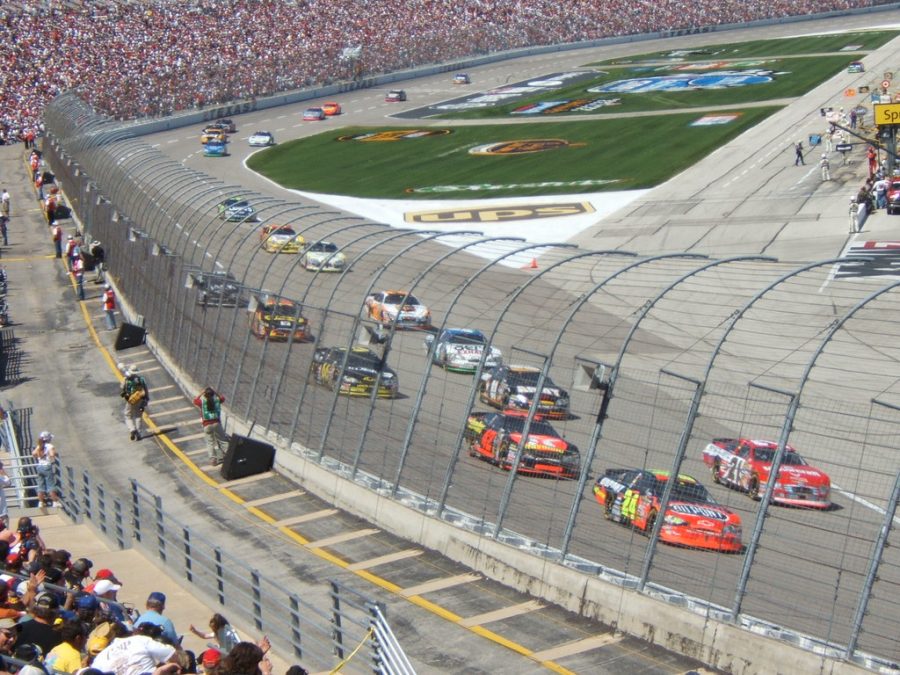NASCAR Cup Series finale at Phoenix can rob sport of history, marks end of an era
November 6, 2021
The field of drivers eligible for the 2021 NASCAR Cup Series championship is set for the finale at Phoenix Raceway on Nov. 7.
For drivers Kyle Larson, Denny Hamlin, Chase Elliott and Martin Truex Jr., the rule are simple — the highest finishing driver after 312 laps wins the championship.
Kyle Larson’s NASCAR career was uncertain a year ago. He was fired from Chip Ganassi Racing in April, the only team he had driven for in his Cup career, after using a racial slur during a virtual race while race track activities were suspended due to the pandemic.
Now, he is not only the favorite to win his first championship in his debut season driving the No. 5 Hendrick Motorsports Chevy Camaro, but he is in the position to cap off one of the most dominant seasons in Cup history.
Larson, who became the 14th driver to lead over 2000 laps in a season, may become the 14th driver to win 10 races in a single season. Larson won three consecutive races on two separate instances and has an average finish of 9.3. His wins include road courses, short tracks and intermediate tracks.
Larsons’ excellent performance isn’t limited to the Cup series. He won other prestigious races this year, including his second consecutive Chili Bowl and his first Knoxville Nationals, both on dirt tracks.
Joe Gibbs Racing’s Denny Hamlin may be the only driver performing comparably to Larson with a higher-average finish of 8.6. However, he hasn’t driven into victory as much as last year, winning only two races compared to seven in 2020.
Driving the No. 11 Toyota Camry, Hamlin has his second consecutive opportunity to win a championship. Last year, he finished fourth behind all the championship-eligible drivers, including crowned-champion Chase Elliot.
Hamlin is regarded to be the best Cup driver in history without a title after winning 46 races, winning three Daytona 500 and qualifying for the playoffs in all but one season. If he added a title, Hamlin could be considered one of the greatest drivers of his era.
Only NASCAR’s unforgiving championship format, in which a mechanical issue or an on-track incident can disrupt a race, may prevent either driver from clinching the title and rewarding their season-long performance.
Kevin Harvick, driver of the No. 4 Stewart-Haas Racing Chevy Camaro, had an arguably better season than Larson last year after winning nine races with an average finish of 7.3, the lowest since Jeff Gordon’s 2007 season. However, he was not eligible to compete for the cup following his elimination in the penultimate Round of 8 this year.
“These championships aren’t like winning like Petty and Earnhardt used to win them,” Harvick told NBCSN following his elimination, referencing the two Cup drivers who won seven championships before NASCAR implemented a playoff system to crown a champion.
Luckily for NASCAR, the two remaining drivers that can rob the sport of history in a second consecutive year are former champions.
After winning five races last year, including the season finale, defending champion Chase Elliott won only two races this year with fewer top 5s, top 10s and laps led. The driver of the No. 9 Chevy only won in road courses this season. For this season at least, Elliott’s premier driver status at Hendrick Motorsports was superseded by teammate Larson.
The fourth eligible driver of the No. 19 Joe Gibbs Racing Toyota and 2017 champion, Martin Truex Jr. won four races this season, including the spring Phoenix race after taking a late-race lead. He led the fourth-most laps this season but is also overshadowed by his teammate Hamlin’s season-long consistency.
At Phoenix in the spring, Hamlin finished third after leading 33 laps, Elliot finished fifth and Larson finished seventh after leading a lap.
The season finale will also mark the end of the Gen-6 race car that was introduced in 2013. While the car was received positively for having added safety measures, improving manufacture brand identity and donning a chassis designed to resemble its street-legal counterparts more closely, its on-track performance polarized fans.
The automotive racing landscape has changed since the car’s launch as well. Ford and Chevy discontinued sales of their sedan models in the United States, switching their race cars to the Mustang and Camaro, respectively. Although Dodge designed a Charger race car, it never raced as the manufacturer couldn’t find a team to field its car.
The Next-Gen race car will launch next year at the Daytona 500, and NASCAR hopes to correct many issues from the current car and introduce new technologies to the series. This car was intended to replace the Gen-6 race car in 2021 but was delayed due to the pandemic.
This will also be the final Cup race to broadcast on Comcast’s NBCSN cable channel , which will shut down at the end of 2021. When the media conglomerate secured the NASCAR media rights in 2013 for the 2015 season through 2024, stock car racing was supposed to be one of the sports network’s main programming anchors along with the NHL and English Premier League.
After the pandemic, the loss of hockey rights to Disney and WarnerMedia, the rise of streaming services and cord cutting, executives surprised the media landscape by distributing a memo announcing NBCSN’s termination.
Comcast is expected to air the second half of the season on NBC and USA Network next year, but there is uncertainty as to whether any races will be streamed exclusively through its Peacock streaming service.








